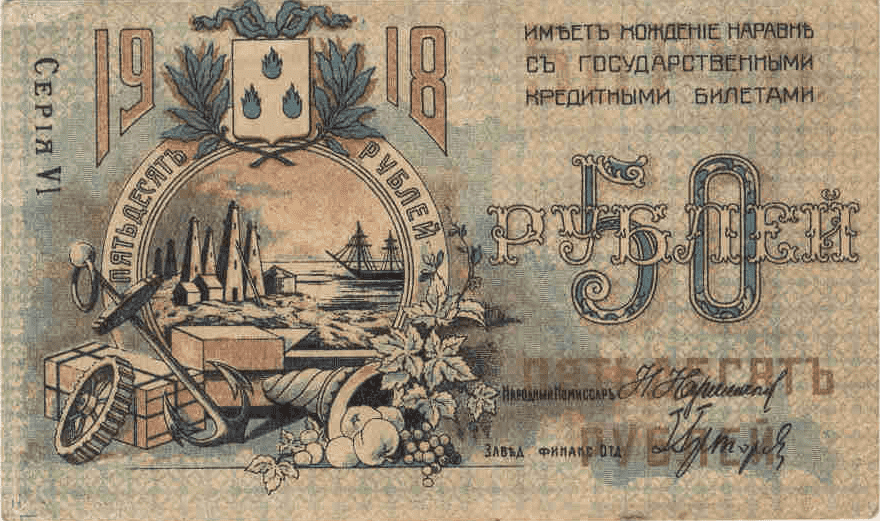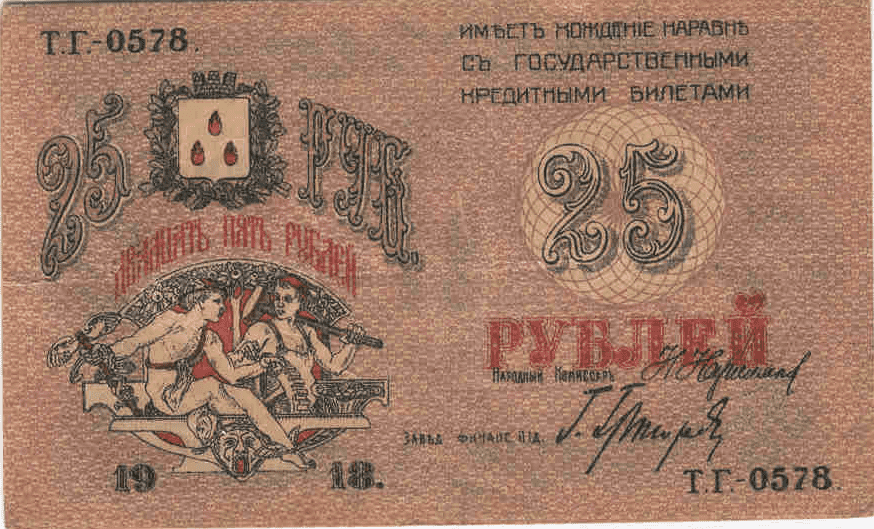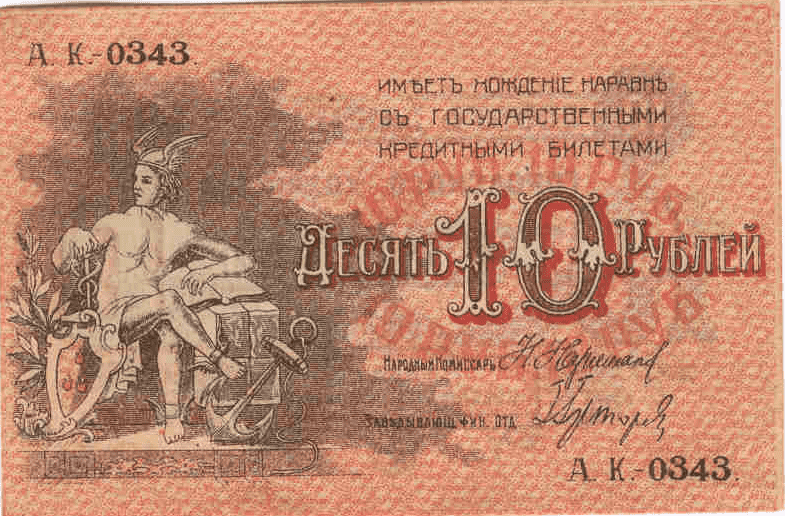Release of Baku bonds (banknotes) into circulation
 The period of existence of the Azerbaijan Democratic Republic is a glorious and at the same time a difficult stage in the history of Azerbaijan. Establishment of an independent state in Azerbaijan required a complete restructuring of the economy. However, the consequences of World War I, anarchy in the South Caucasus during the period of dual power, the plunder of national wealth by the Bolshevik-Dashnak government - the Baku Soviet and the dictatorship of the "Centro-Caspian" and, also the collapse of the economy as a result of the country being under the influence of foreign troops during the period of building an independent state put the government in a difficult position. The main task of the government in the field of economics was not only the restoration of the destroyed agriculture, but also the definition of the principles of the new economic system and the beginning of reforms on these principles. The most important of these reforms were the steps that had to be taken in the field of the national currency.
The period of existence of the Azerbaijan Democratic Republic is a glorious and at the same time a difficult stage in the history of Azerbaijan. Establishment of an independent state in Azerbaijan required a complete restructuring of the economy. However, the consequences of World War I, anarchy in the South Caucasus during the period of dual power, the plunder of national wealth by the Bolshevik-Dashnak government - the Baku Soviet and the dictatorship of the "Centro-Caspian" and, also the collapse of the economy as a result of the country being under the influence of foreign troops during the period of building an independent state put the government in a difficult position. The main task of the government in the field of economics was not only the restoration of the destroyed agriculture, but also the definition of the principles of the new economic system and the beginning of reforms on these principles. The most important of these reforms were the steps that had to be taken in the field of the national currency.
The Government of the Azerbaijan Democratic Republic has taken important steps to prevent inflation, regulate wages and money circulation in conditions of inflation, and create a national currency.
82 of the 315 draft laws submitted during the activities of the Parliament of the Azerbaijan Democratic Republic were presented by the Ministry of Finance. In order to rectify the difficult financial situation of the young state, and to save the financial system from a serious crisis, the government was forced to issue new money called "Baku bonds".
 The absence of any rules and any reports on Baku bonds issued during the reign of the Baku Soviet - from the beginning of 1918 to the end of March 1918 did not guarantee the availability of funds. During this period, 4 currencies were in circulation in the country: the rubles of the tsarist government (the so-called "Nikolaev"), the rubles of the Provisional Government ("Kerenki"), Transcaucasian government bonds issued in Tiflis, and Baku bonds. All these currencies were in circulation as legal tender. Due to the circumstances, on September 22, 1918, the government adopted a resolution on the introduction of Baku bonds into circulation. According to the decree, 40 manats (Baku bonds) was equal to 1 Turkish lira. Withdrawal of other monetary units from circulation has not yet been planned.
The absence of any rules and any reports on Baku bonds issued during the reign of the Baku Soviet - from the beginning of 1918 to the end of March 1918 did not guarantee the availability of funds. During this period, 4 currencies were in circulation in the country: the rubles of the tsarist government (the so-called "Nikolaev"), the rubles of the Provisional Government ("Kerenki"), Transcaucasian government bonds issued in Tiflis, and Baku bonds. All these currencies were in circulation as legal tender. Due to the circumstances, on September 22, 1918, the government adopted a resolution on the introduction of Baku bonds into circulation. According to the decree, 40 manats (Baku bonds) was equal to 1 Turkish lira. Withdrawal of other monetary units from circulation has not yet been planned.
After the first decision of the government of the Republic, which has always paid special attention to issues related to paper money, dated September 22, 1918, on the introduction of Baku bonds into circulation, a second decision was adopted on September 25, 1918, on the issuance of another 30 million manat bonds with a nominal value 10, 25 and 50 bonds and on the allocation of a loan for this in in the amount of 150,000 manats.
 On October 9, 1918, the government established a single exchange rate for all monetary units in circulation in the republic. On January 27, 1919, a resolution was adopted on the joint issue with Georgia of 40 million Bons of the South Caucasian model (the republics were to receive 20 million Bons each). On March 30, 1919, the Government of the Republic adopted a resolution to issue a banknote of 100 manats in addition to the existing banknotes. On June 6, by a government decree of March 3, 1919, the free exchange of 100-manat banknotes from Baku bonds to Transcaucasian bonds was allowed. Since March 11, the issue of bonds has been resumed. The rules for the storage and accounting of issued banknotes in the Baku Treasury were determined by the government decree of April 2, 1919. From April 23, the free exchange of Baku bonds to Transcaucasian bonds, as well as their release to the Azerbaijani market, has been allowed. The decree adopted by the government on May 26, 1919, set out in detail the rules for accepting and replacing dilapidated monetary currencies, as well as administrative measures to be taken against treasury cashiers who refused to accept such currencies. Since November 8, 1919, the state cash registers of all departments were allowed to accept banknotes of the Azerbaijan Democratic Republic, the Baku City Self-Government, the Baku Municipal Economy Council and the Transcaucasian Commissariat. According to the law adopted by the Parliament on December 1, 1919, the government was allowed to issue banknotes of the Azerbaijan Democratic Republic in the amount of 600 million manats. The issue of Baku bonds played an important role in stabilizing the financial and economic situation of the independent state and conducting an independent financial policy.
On October 9, 1918, the government established a single exchange rate for all monetary units in circulation in the republic. On January 27, 1919, a resolution was adopted on the joint issue with Georgia of 40 million Bons of the South Caucasian model (the republics were to receive 20 million Bons each). On March 30, 1919, the Government of the Republic adopted a resolution to issue a banknote of 100 manats in addition to the existing banknotes. On June 6, by a government decree of March 3, 1919, the free exchange of 100-manat banknotes from Baku bonds to Transcaucasian bonds was allowed. Since March 11, the issue of bonds has been resumed. The rules for the storage and accounting of issued banknotes in the Baku Treasury were determined by the government decree of April 2, 1919. From April 23, the free exchange of Baku bonds to Transcaucasian bonds, as well as their release to the Azerbaijani market, has been allowed. The decree adopted by the government on May 26, 1919, set out in detail the rules for accepting and replacing dilapidated monetary currencies, as well as administrative measures to be taken against treasury cashiers who refused to accept such currencies. Since November 8, 1919, the state cash registers of all departments were allowed to accept banknotes of the Azerbaijan Democratic Republic, the Baku City Self-Government, the Baku Municipal Economy Council and the Transcaucasian Commissariat. According to the law adopted by the Parliament on December 1, 1919, the government was allowed to issue banknotes of the Azerbaijan Democratic Republic in the amount of 600 million manats. The issue of Baku bonds played an important role in stabilizing the financial and economic situation of the independent state and conducting an independent financial policy.
Recommended literature:
- Mustafa, Nazim. Azərbaycan Xalq Cümhuriyyəti işığında: 1918-1920: araşdırmalar, məqalələr / N. Mustafa. - Bakı: Ulu İKF, 2018. - 256 s.
Qurbanov, Çingiz Nəbi oğlu. Azərbaycanda pul tədavülü və bank işinin təkamülü: b.e.ə. IX əsr - 2014-cü il / Ç. N. Qurbanov.- Bakı: Avropa, 2018.- 547 s. - Azərbaycan Xalq Cümhuriyyəti Ensiklopediyası : 2 cilddə / red. heyəti: Y. M. Mahmudov [et al.] ; baş red. Y. M. Mahmudov. I cild. - Bakı : Lider nəşriyyat, 2004. - 440 s.
- Azərbaycan Xalq Cümhuriyyəti Ensiklopediyası : 2 cilddə / red. heyəti Y. M. Mahmudov [et al.] ; baş red. Y. M. Mahmudov. II cild. - Bakı : Lider nəşriyyat, 2005. - 472 s.
- Azərbaycan Cümhuriyyəti: 1918-1920 / Azərbaycan Respublikası EA A.A.Bakıxanov ad. Tarix İnstitutu. - Bakı: Elm, 1998. - 336 с.
- Волхонский, Михаил. По следам Азербайджанской Демократической Республики / М. Волхонский, В. Муханов. - М.: Европа, 2007. - 256 с.
- Азербайджанская Демократическая Республика: 1918-1920 / Институт Истории АН Азербайджанской ССР. - Баку: Элм, 1998. - 316 с.
- Isgenderli, Anar. Realities of Azerbaijan: 1917-1920 / A. İsgenderli; trans. Y. Axundov. - w. c.: Xlibris Corporation, 2011. - 234 p.